Selective Insurance Group Bundle
Can Selective Insurance Group Maintain Its Growth Trajectory?
Selective Insurance Group, a prominent player in the U.S. property and casualty insurance market, is navigating a dynamic landscape. Founded in 1926, the company has consistently demonstrated a commitment to profitable expansion. Despite recent challenges, including industry-wide pressures, Selective Insurance Group's future prospects remain a key area of interest for investors and industry watchers alike.
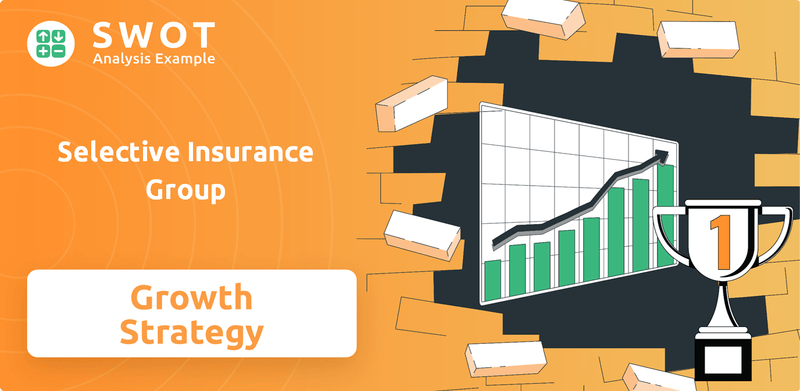
Selective Insurance Group's strategic planning and financial performance are crucial in understanding its potential. Selective Insurance Group SWOT Analysis provides a deeper dive into the company's strengths, weaknesses, opportunities, and threats, offering valuable insights for anyone looking to understand the insurance market and the future of Selective Insurance Group. Examining its growth strategy, including market expansion and technological integration, is key to assessing its long-term investment opportunities and competitive landscape.
How Is Selective Insurance Group Expanding Its Reach?
The Selective Insurance Group is actively pursuing several expansion initiatives to broaden its market reach and diversify its business. Their growth strategy involves a multi-pronged approach, focusing on both geographical expansion and product diversification within the insurance market. This strategic planning is designed to enhance financial performance and capitalize on emerging opportunities.
A key element of Selective Insurance Group's growth strategy is increasing its market share in Standard Commercial Lines. The company aims to reach 12% of its agents' premiums and is strategically appointing new agents to achieve this goal. This focus on agent growth and premium volume is a core part of their overall business model.
Selective Insurance Group's expansion plans include a significant focus on geographical growth. Since 2017, they have added thirteen states to their Standard Commercial Lines footprint. In 2024 alone, Selective began writing Standard Commercial Lines business in five new states: Maine, Nevada, Oregon, Washington, and West Virginia. This expansion brought them closer to their goal of a near-national footprint for this segment. These new states contributed $350 million in premium, representing approximately 10% of Standard Commercial Lines Net Premiums Written (NPW).
Selective Insurance Group's strategic goals include expanding its presence across the United States. The company plans to enter Kansas, Montana, and Wyoming by the end of 2026, further solidifying its national reach. This expansion is a key part of their strategic planning for future growth.
Beyond geographical expansion, Selective is focusing on product and segment growth, particularly in its Excess and Surplus (E&S) Lines. The E&S segment has shown exceptional performance, achieving a 29% growth in 2024.
The Excess and Surplus (E&S) Lines segment surpassed $500 million in net premiums written for the first time. In the first quarter of 2025, E&S Lines net premiums written grew by 20% compared to the prior-year period.
Selective is implementing underwriting refinements in its general liability line of business. This includes managing limits and coverage grants in challenging jurisdictions and focusing production on better-performing classes of business. This is part of their underwriting strategy.
Selective's growth strategy is driven by several key factors, including strong policy count growth, average renewal pure price increases, and new business growth. These elements are critical for the company's revenue growth and overall financial performance.
- Geographic expansion into new states.
- Focus on high-performing segments like E&S Lines.
- Strategic underwriting adjustments in general liability.
- Agent network expansion and premium growth targets.
Selective Insurance Group SWOT Analysis
- Complete SWOT Breakdown
- Fully Customizable
- Editable in Excel & Word
- Professional Formatting
- Investor-Ready Format
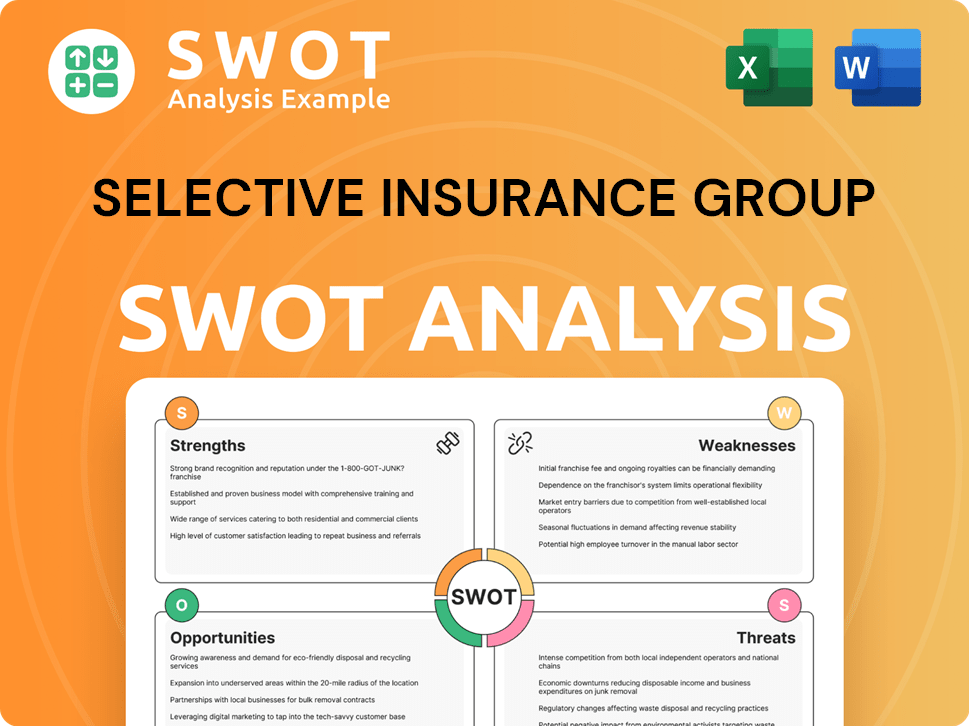
How Does Selective Insurance Group Invest in Innovation?
Selective Insurance Group recognizes that innovation and technology are vital for achieving its growth strategy and maintaining a competitive edge within the insurance market. The company is heavily invested in digital transformation, aiming to improve operational efficiencies and enhance the customer experience. This focus is crucial for navigating the evolving landscape of the insurance industry and ensuring sustained financial performance.
The company's approach involves integrating advanced tools and technologies to streamline processes, from risk assessment to claims management. This commitment to technological advancement is designed to improve underwriting profitability and optimize overall business outcomes. By leveraging these tools, Selective Insurance Group aims to make data-driven decisions and provide superior service.
Selective Insurance Group is actively developing and implementing artificial intelligence (AI) use cases to enhance its operations. These initiatives are specifically targeted at improving underwriting scalability and optimizing claims outcomes. This strategic use of AI is a key component of the company's plan to streamline processes, enhance accuracy, and contribute to its growth objectives. The integration of people and technology is also a key factor in delivering a superior omni-channel customer experience.
Selective Insurance Group is making significant investments in digital transformation to modernize its operations. These investments include upgrading core systems and implementing new technologies to improve efficiency and customer service. The goal is to create a more agile and responsive business model.
The company is leveraging AI and machine learning to enhance various aspects of its business. This includes using AI for risk assessment, fraud detection, and claims processing. These technologies help to improve accuracy and efficiency, leading to better financial performance.
Selective Insurance Group is focused on providing a seamless omni-channel customer experience. This involves integrating digital channels with traditional methods to offer customers flexibility and convenience. The goal is to improve customer satisfaction and loyalty.
Data analytics plays a crucial role in Selective Insurance Group's strategy. The company uses data to gain insights into customer behavior, market trends, and risk factors. This data-driven approach helps in making informed decisions and improving business outcomes.
Selective Insurance Group is automating its underwriting processes to improve efficiency and accuracy. This involves using technology to assess risk, price policies, and make decisions more quickly. Automation helps to reduce costs and improve turnaround times.
The company is investing in technology to streamline its claims processing. This includes using digital tools to expedite the claims process, improve accuracy, and enhance customer satisfaction. Efficient claims processing is crucial for maintaining customer trust and loyalty.
Selective Insurance Group's technology initiatives are designed to support its growth strategy and improve its financial performance. These initiatives are focused on enhancing operational efficiency, improving customer service, and driving innovation within the Marketing Strategy of Selective Insurance Group. The company's commitment to digital transformation is a key factor in its long-term success.
- AI-Driven Underwriting: Implementing AI to automate and improve the accuracy of risk assessment and policy pricing.
- Advanced Analytics: Utilizing data analytics to gain deeper insights into customer behavior, market trends, and risk factors.
- Digital Customer Portals: Developing user-friendly online platforms to enhance the customer experience and streamline interactions.
- Automation of Claims Processing: Employing technology to expedite the claims process, reduce costs, and improve customer satisfaction.
- Cybersecurity Enhancements: Investing in robust cybersecurity measures to protect sensitive data and maintain customer trust.
Selective Insurance Group PESTLE Analysis
- Covers All 6 PESTLE Categories
- No Research Needed – Save Hours of Work
- Built by Experts, Trusted by Consultants
- Instant Download, Ready to Use
- 100% Editable, Fully Customizable
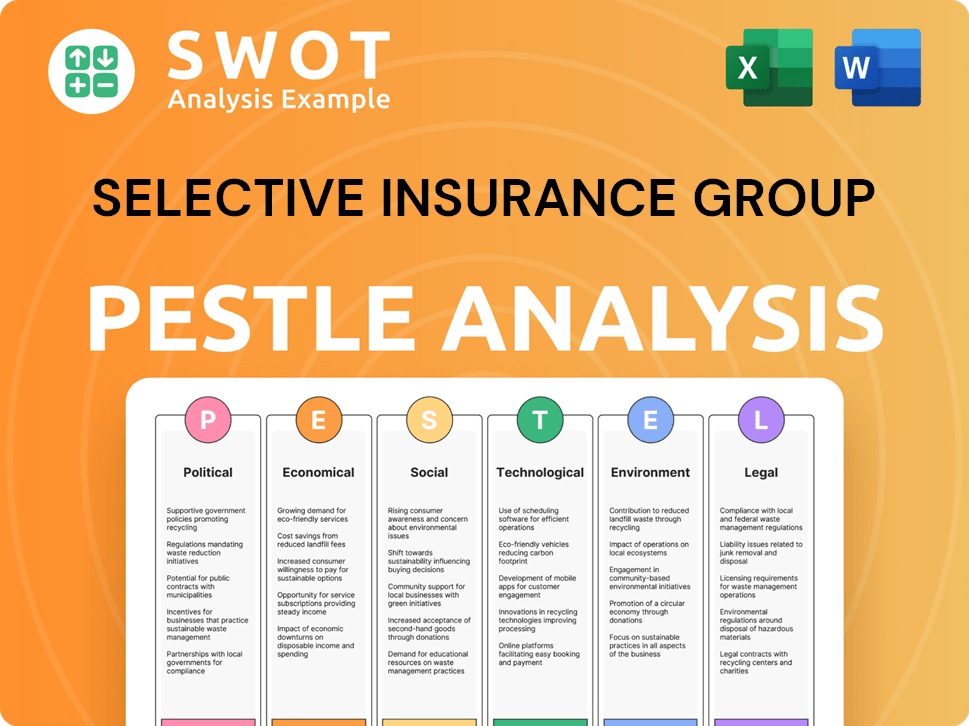
What Is Selective Insurance Group’s Growth Forecast?
The financial outlook for Selective Insurance Group in 2025 indicates a path toward improved performance after a challenging 2024. The company projects a GAAP combined ratio between 96% and 97% for the full year, which includes an expected catastrophe loss ratio of 6%. This is a notable improvement from the 103% combined ratio reported in 2024, which was affected by significant catastrophe losses and social inflation-related reserving actions. This improvement is a key part of their Mission, Vision & Core Values of Selective Insurance Group.
Analysts are estimating a healthy operating Return on Equity (ROE) of approximately 15% for 2025. This is a substantial increase from the 7.5% projected for 2024. This positive outlook is supported by Selective's pricing strategies and anticipated improvements in the combined ratio. Net investment income (NII) is projected to be $405 million after-tax for 2025, which provides a stable buffer against underwriting volatility.
In the first quarter of 2025, Selective reported a 7% year-over-year increase in net premiums written, reaching $1.24 billion. This growth was primarily driven by renewal pure price increases of 10.3%. The company's book value per common share also increased by 5% during the first quarter of 2025, reaching $50.33. Selective's strategic financial moves, such as the $400 million senior notes issuance in February 2025, enhance financial flexibility and support organic growth opportunities.
The projected combined ratio improvement from 103% in 2024 to 96%-97% in 2025 is a critical indicator of improved financial performance. This reflects the effectiveness of the company's underwriting strategies and pricing adjustments. This improvement is crucial for the long-term growth strategy of the insurance company.
The estimated increase in operating ROE to approximately 15% in 2025, compared to 7.5% in 2024, highlights improved profitability. This increase is driven by better underwriting results and strong investment income, which are key factors in the company's financial performance and strategic planning.
The projected $405 million after-tax net investment income for 2025 provides a financial cushion against underwriting volatility. In the first quarter of 2025, after-tax net investment income increased 12% year-over-year to $96 million, contributing 12.8 points of annualized ROE. This financial stability is crucial for navigating the insurance market.
The 7% year-over-year increase in net premiums written in Q1 2025, driven by a 10.3% increase in renewal pure price, indicates effective pricing strategies. This growth, coupled with the company's underwriting strategy, supports the overall revenue growth and market share.
The $400 million senior notes issuance in February 2025 enhances financial flexibility. This strengthens the company's position to pursue organic growth opportunities and manage potential risks, which supports long-term strategic goals.
The 5% increase in book value per common share to $50.33 during Q1 2025 demonstrates the company's ability to create shareholder value. This growth is supported by strong financial performance and strategic financial management, reflecting positively on the company's stock forecast.
Selective Insurance Group Business Model Canvas
- Complete 9-Block Business Model Canvas
- Effortlessly Communicate Your Business Strategy
- Investor-Ready BMC Format
- 100% Editable and Customizable
- Clear and Structured Layout
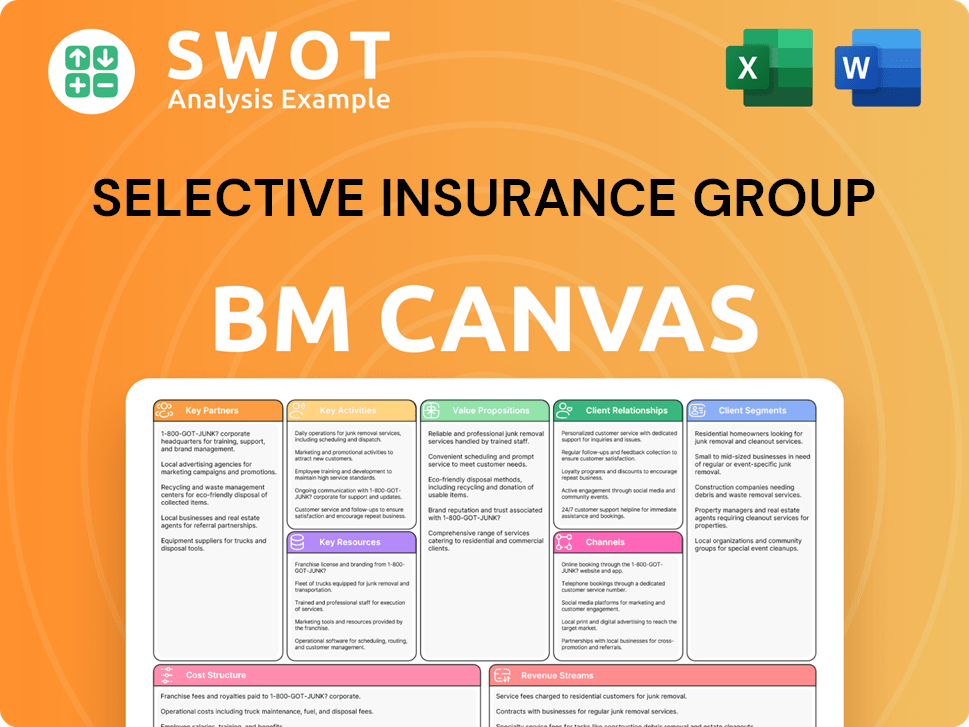
What Risks Could Slow Selective Insurance Group’s Growth?
The path to growth for Selective Insurance Group is fraught with potential risks and obstacles. The company faces challenges related to its underwriting practices, competitive pressures, and external economic factors. Understanding these risks is crucial for assessing the company's future prospects and investment potential. For a deeper understanding of the company, consider exploring the Brief History of Selective Insurance Group.
One significant risk stems from the elevated loss trends in casualty lines, especially due to social inflation. Selective Insurance Group's high exposure to these lines, primarily in the U.S., and its focus on contractor insurance, exacerbate this risk. The company has experienced repeated reserve charges, which have negatively impacted its financial performance and eroded investor confidence. In the fourth quarter of 2024, a $100 million unfavorable prior-year reserve development significantly impacted earnings.
Competitive pressures within the property and casualty insurance market also pose a threat to Selective Insurance Group. Regulatory changes or adverse developments in tort reform could further impact the company's profitability. Macroeconomic uncertainties, including prolonged higher inflation, could increase loss costs and negatively affect investment portfolio performance. Selective's geographic concentration in the eastern United States also presents a risk, particularly concerning catastrophe losses. While the company aims for a GAAP combined ratio of 96% to 97% in 2025, this estimate assumes no additional prior-year casualty reserve development, highlighting the ongoing risk of reserve inadequacies. Management assesses and prepares for these risks through disciplined underwriting, pricing actions, and continuous monitoring of results.
Social inflation, driven by increased litigation and larger awards, significantly raises insurance costs. This trend is particularly concerning for Selective Insurance Group due to its exposure to casualty lines.
Repeated reserve charges, totaling $371 million over five quarters, indicate potential issues with reserve adequacy. The company's 2025 combined ratio target relies on no further reserve development, highlighting the ongoing risk.
The property and casualty insurance market is highly competitive, with pricing pressures and regulatory changes posing challenges. Selective Insurance Group must navigate these dynamics to maintain profitability.
Macroeconomic factors, such as inflation, can increase loss costs and impact investment returns. Selective Insurance Group's financial performance is sensitive to these broader economic trends.
Selective Insurance Group's business concentration in the eastern United States increases its exposure to catastrophe losses. This geographic focus presents a specific risk factor.
Disciplined underwriting and pricing actions are crucial for managing risks. Selective Insurance Group's strategic goals depend on effective implementation of these practices.
Social Inflation: Rising insurance costs due to increased litigation and larger awards in casualty lines. Selective Insurance Group has a high exposure to these lines.
Reserve Development: Prior-year reserve charges have negatively impacted financial performance. The 2025 combined ratio target relies on no further reserve development.
Competitive Pressures: The property and casualty insurance market is highly competitive, with potential impacts from regulatory changes.
Macroeconomic Uncertainties: Inflation and other economic factors can affect loss costs and investment portfolio performance.
Selective Insurance Group Porter's Five Forces Analysis
- Covers All 5 Competitive Forces in Detail
- Structured for Consultants, Students, and Founders
- 100% Editable in Microsoft Word & Excel
- Instant Digital Download – Use Immediately
- Compatible with Mac & PC – Fully Unlocked
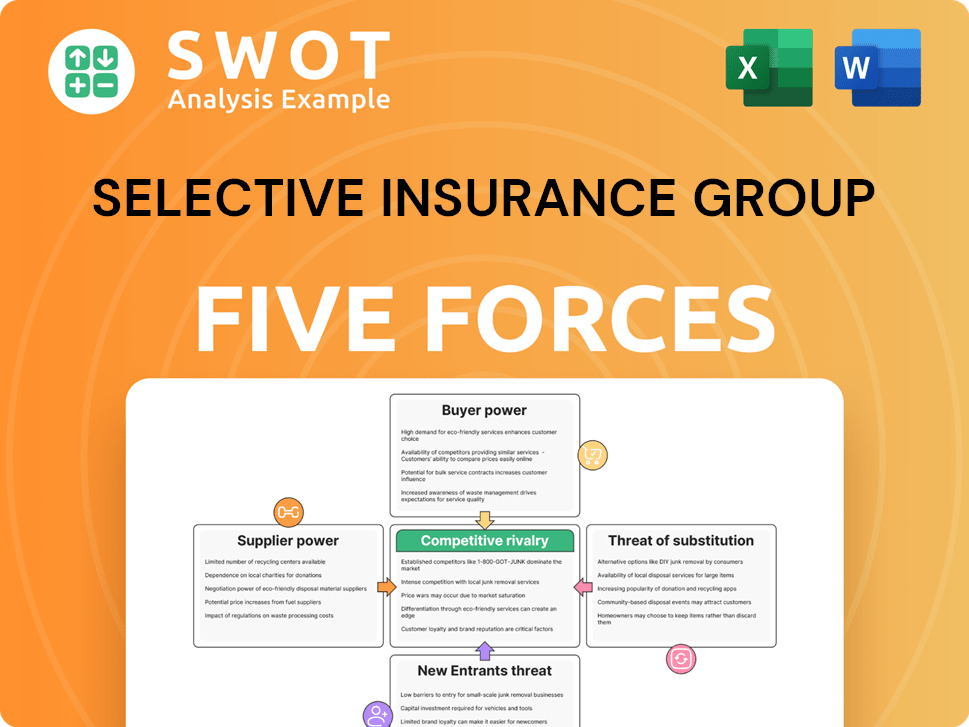
Related Blogs
- What are Mission Vision & Core Values of Selective Insurance Group Company?
- What is Competitive Landscape of Selective Insurance Group Company?
- How Does Selective Insurance Group Company Work?
- What is Sales and Marketing Strategy of Selective Insurance Group Company?
- What is Brief History of Selective Insurance Group Company?
- Who Owns Selective Insurance Group Company?
- What is Customer Demographics and Target Market of Selective Insurance Group Company?
Disclaimer
All information, articles, and product details provided on this website are for general informational and educational purposes only. We do not claim any ownership over, nor do we intend to infringe upon, any trademarks, copyrights, logos, brand names, or other intellectual property mentioned or depicted on this site. Such intellectual property remains the property of its respective owners, and any references here are made solely for identification or informational purposes, without implying any affiliation, endorsement, or partnership.
We make no representations or warranties, express or implied, regarding the accuracy, completeness, or suitability of any content or products presented. Nothing on this website should be construed as legal, tax, investment, financial, medical, or other professional advice. In addition, no part of this site—including articles or product references—constitutes a solicitation, recommendation, endorsement, advertisement, or offer to buy or sell any securities, franchises, or other financial instruments, particularly in jurisdictions where such activity would be unlawful.
All content is of a general nature and may not address the specific circumstances of any individual or entity. It is not a substitute for professional advice or services. Any actions you take based on the information provided here are strictly at your own risk. You accept full responsibility for any decisions or outcomes arising from your use of this website and agree to release us from any liability in connection with your use of, or reliance upon, the content or products found herein.